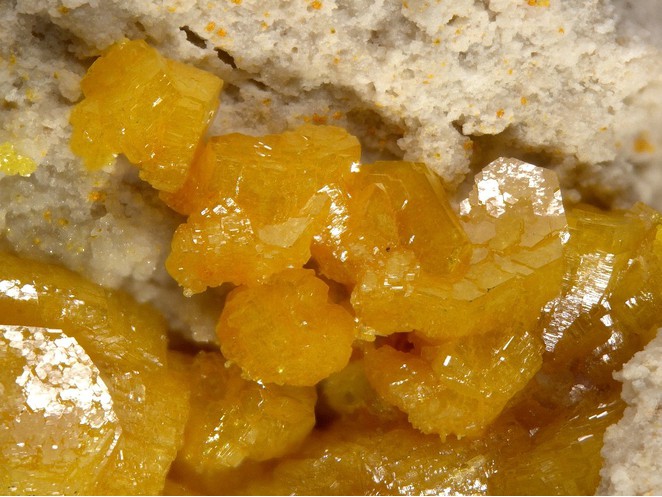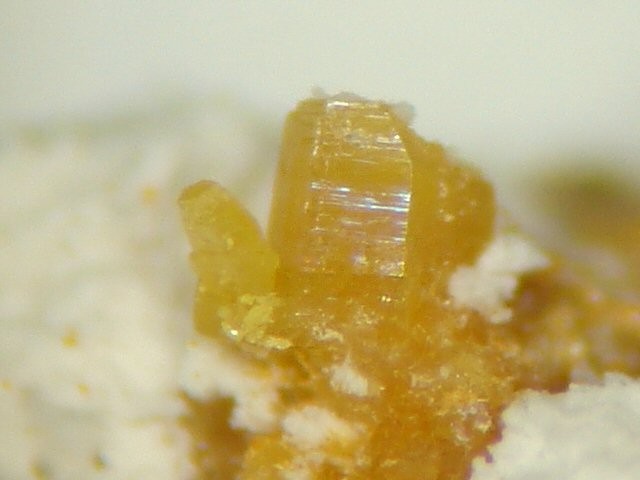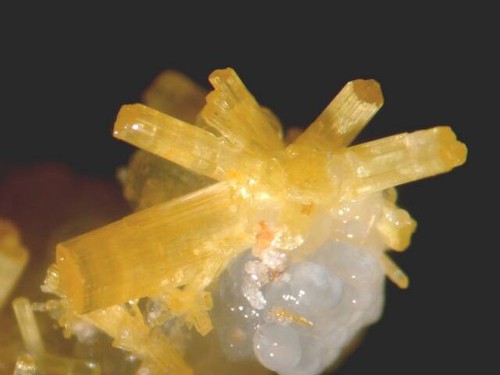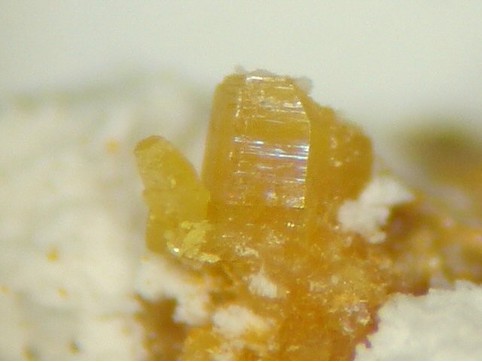Kleinite
A valid IMA mineral species - grandfathered
This page is currently not sponsored. Click here to sponsor this page.
About Kleinite
Formula:
(Hg2N)(Cl,SO4) · nH2O
Colour:
Light to canary-yellow, orange; darkens to reddish yellow or orange in daylight and reverts to original color in darkness. Yellow to colourless in transmitted light.
Lustre:
Adamantine, Greasy
Hardness:
3½
Crystal System:
Hexagonal
Name:
Named in 1905 by Arthur Sachs in honor of Johann Friedrich Carl Klein [15 September 1842 Hannau, Germany - 23 June 1907 Berlin, Germany], German Professor of Mineralogy and curator of the Museum für Naturkunde, University of Berlin. Klein was a petrographer who made major contributions to understanding mineral optics and the indentification of minerals in thin sections. He was a pioneer in studying meteorites in thin section.
Type Locality:
Dimorph of:
This page provides mineralogical data about Kleinite.
Unique Identifiers
Mindat ID:
2225
Long-form identifier:
mindat:1:1:2225:1
GUID
(UUID V4):
(UUID V4):
30fb956e-61f8-4320-bfb2-6c0fb1b106d1
IMA Classification of Kleinite
Approved, 'Grandfathered' (first described prior to 1959)
First published:
1905
Classification of Kleinite
3.DD.35
3 : HALIDES
D : Oxyhalides, hydroxyhalides and related double halides
D : With Hg
3 : HALIDES
D : Oxyhalides, hydroxyhalides and related double halides
D : With Hg
10.4.3.1
10 : OXYHALIDES AND HYDROXYHALIDES
4 : A2(O,OH)Xq
10 : OXYHALIDES AND HYDROXYHALIDES
4 : A2(O,OH)Xq
26.16
26 : Sulphates with Halide
26 : Sulphates with Halide
Mineral Symbols
As of 2021 there are now IMA–CNMNC approved mineral symbols (abbreviations) for each mineral species, useful for tables and diagrams.
| Symbol | Source | Reference |
|---|---|---|
| Kle | IMA–CNMNC | Warr, L.N. (2021). IMA–CNMNC approved mineral symbols. Mineralogical Magazine, 85(3), 291-320. doi:10.1180/mgm.2021.43 |
Physical Properties of Kleinite
Adamantine, Greasy
Transparency:
Transparent, Translucent
Colour:
Light to canary-yellow, orange; darkens to reddish yellow or orange in daylight and reverts to original color in darkness. Yellow to colourless in transmitted light.
Streak:
Yellow
Hardness:
3½ on Mohs scale
Tenacity:
Brittle
Cleavage:
Distinct/Good
On {0001} easy but uneven; on {1010}, imperfect.
On {0001} easy but uneven; on {1010}, imperfect.
Optical Data of Kleinite
Type:
Uniaxial (+)
RI values:
nω = 2.190 nε = 2.210
Max Birefringence:
δ = 0.020

Image shows birefringence interference colour range (at 30µm thickness)
and does not take into account mineral colouration.
and does not take into account mineral colouration.
Surface Relief:
Very High
Comments:
Biaxial below 130°C (biaxial negative) and uniaxial above 130°C (uniaxial positive). Isotropic above aproximately 190°C.
Chemistry of Kleinite
Mindat Formula:
(Hg2N)(Cl,SO4) · nH2O
Crystallography of Kleinite
Crystal System:
Hexagonal
Class (H-M):
6/mmm (6/m 2/m 2/m) - Dihexagonal Dipyramidal
Space Group:
P63/mmc
Cell Parameters:
a = 6.762(2) Å, c = 11.068(3) Å
Ratio:
a:c = 1 : 1.637
Unit Cell V:
438.3 ų
Z:
4
Morphology:
Crystals short prismatic [0001] with variable development of {10-11}; equidimensional at times. Crystals are anomalously birefringent - true symmetry may be monoclinic or triclinic, due to ordering of zeolitic chloride, sulfate and water, and. apparently hexagonal crystals may be highly twinned and/or pseudomorphs of truly hexagonal high-temperature polymorph (birefringence vanishes above 130°C).
Comment:
data from Giester et al. (1996)
Crystal Structure
Load
Unit Cell | Unit Cell Packed
2x2x2 | 3x3x3 | 4x4x4
Unit Cell | Unit Cell Packed
2x2x2 | 3x3x3 | 4x4x4
Show
Big Balls | Small Balls | Just Balls | Spacefill
Polyhedra Off | Si Polyhedra | All Polyhedra
Remove metal-metal sticks
Big Balls | Small Balls | Just Balls | Spacefill
Polyhedra Off | Si Polyhedra | All Polyhedra
Remove metal-metal sticks
Display Options
Black Background | White Background
Perspective On | Perspective Off
2D | Stereo | Red-Blue | Red-Cyan
Black Background | White Background
Perspective On | Perspective Off
2D | Stereo | Red-Blue | Red-Cyan
View
CIF File Best | x | y | z | a | b | c
CIF File Best | x | y | z | a | b | c
Rotation
Stop | Start
Stop | Start
Labels
Console Off | On | Grey | Yellow
Console Off | On | Grey | Yellow
Data courtesy of the American Mineralogist Crystal Structure Database. Click on an AMCSD ID to view structure
| ID | Species | Reference | Link | Year | Locality | Pressure (GPa) | Temp (K) |
|---|---|---|---|---|---|---|---|
| 0014883 | Kleinite | Giester G, Mikenda W, Pertlik F (1996) Kleinite from Terlingua, Brewster County, Texas: Investigations by single crystal X-ray diffraction, and vibrational spectroscopy Neues Jahrbuch fur Mineralogie, Monatshefte 1996 49-56 | 1996 | Terlingua, Brewster County, Texas, USA | 0 | 403 |
CIF Raw Data - click here to close
X-Ray Powder Diffraction
Powder Diffraction Data:
| d-spacing | Intensity |
|---|---|
| 2.914 Å | (10) |
| 2.615 Å | (10) |
| 3.884 Å | (6) |
| 2.013 Å | (6) |
| 1.434 Å | (4) |
| 1.242 Å | (4) |
| 5.228 Å | (2) |
Geological Environment
Paragenetic Mode(s):
| Paragenetic Mode | Earliest Age (Ga) |
|---|---|
| High-𝑇 alteration and/or metamorphism | |
| 33 : Minerals deposited by hydrothermal metal-rich fluids (see also [#12]) | |
| Stage 7: Great Oxidation Event | <2.4 |
| 46 : Near-surface hydrothermal alteration of minerals (see also #22) | |
| 47b : [Sulfates and sulfites] | |
| 47g : [Halogen-bearing surface weathering minerals] |
Type Occurrence of Kleinite
Place of Conservation of Type Material:
Harvard University, Cambridge, Massachusetts, USA.
National Museum of Natural History (Smithsonian), Washington, D.C., USA, 86639–86641, 86647.
National Museum of Natural History (Smithsonian), Washington, D.C., USA, 86639–86641, 86647.
Associated Minerals at Type Locality:
Reference:
Sachs, A. (1905) Der Kleinit, ein hexagonales Quecksilberoxychlorid von Terlingua in Texas. Sitzungsberichte der Königlich Preussischen Akademie der Wissenschaften: 1905: 1091-1094.
Synonyms of Kleinite
Mercurammonite (in part)
Other Language Names for Kleinite
Common Associates
Associated Minerals Based on Photo Data:
| 25 photos of Kleinite associated with Terlinguacreekite | Hg2+3Cl2O2 |
| 12 photos of Kleinite associated with Quartz | SiO2 |
| 9 photos of Kleinite associated with Opal-AN | SiO2 · nH2O |
| 7 photos of Kleinite associated with Cinnabar | HgS |
| 7 photos of Kleinite associated with Calcite | CaCO3 |
| 7 photos of Kleinite associated with Comancheite | Hg2+55N3-24(NH2,OH)4(Cl,Br)34 |
| 4 photos of Kleinite associated with Opal | SiO2 · nH2O |
| 3 photos of Kleinite associated with Mosesite | (Hg2N)(Cl,SO4,MoO4) · H2O |
| 3 photos of Kleinite associated with Goethite | α-Fe3+O(OH) |
| 3 photos of Kleinite associated with Montroydite | HgO |
Related Minerals - Strunz-mindat Grouping
| 3.DD. | Mikecoxite | [CHg4]OCl2 |
| 3.DD.05 | Eglestonite | [Hg2]2+3OCl3(OH) |
| 3.DD.05 | Kadyrelite | [Hg2]2+3OBr3(OH) |
| 3.DD.10 | Poyarkovite | [Hg2]2+3Cl2O2 |
| 3.DD.15 | Hanawaltite | [Hg2]2+3Hg2+(Cl,OH)2O3 |
| 3.DD.20 | Terlinguaite | [Hg3]4+Hg2+Cl2O2 |
| 3.DD.25 | Pinchite | Hg2+5Cl2O4 |
| 3.DD.30 | Gianellaite | [(Hg2N)2](SO4)(H2O)x |
| 3.DD.30 | Mosesite | (Hg2N)(Cl,SO4,MoO4) · H2O |
| 3.DD.40 | Tedhadleyite | [Hg2]2+5Hg2+I2(Cl,Br)2O4 |
| 3.DD.45 | Vasilyevite | [Hg2]2+10I3Br2Cl[CO3]O6 |
| 3.DD.50 | Aurivilliusite | [Hg2]2+Hg2+2(I,Br,Cl)2O2 |
| 3.DD.55 | Terlinguacreekite | Hg2+3Cl2O2 |
| 3.DD.60 | Kelyanite | [Hg]2+6Sb3+BrCl2O6 |
| 3.DD.65 | Comancheite | Hg2+55N3-24(NH2,OH)4(Cl,Br)34 |
| 3.DD.70 | Gaildunningite | Hg2+3[NHg2+2]18(Cl,I,OH,Br,S)24 |
Other Information
Thermal Behaviour:
Optical properties vary with temperature.
Notes:
Soluble in warm HCl and HNO3 without deposition of calomel. Soluble in ammonium bromide with evolution of ammonia.
Health Risks:
No information on health risks for this material has been entered into the database. You should always treat mineral specimens with care.
Internet Links for Kleinite
mindat.org URL:
https://www.mindat.org/min-2225.html
Please feel free to link to this page.
Please feel free to link to this page.
Search Engines:
External Links:
Mineral Dealers:
References for Kleinite
Reference List:
Localities for Kleinite
Locality List
 - This locality has map coordinates listed.
- This locality has map coordinates listed.
 - This locality has estimated coordinates.
ⓘ - Click for references and further information on this occurrence.
? - Indicates mineral may be doubtful at this locality.
- This locality has estimated coordinates.
ⓘ - Click for references and further information on this occurrence.
? - Indicates mineral may be doubtful at this locality.
 - Good crystals or important locality for species.
- Good crystals or important locality for species.
 - World class for species or very significant.
(TL) - Type Locality for a valid mineral species.
(FRL) - First Recorded Locality for everything else (eg varieties).
- World class for species or very significant.
(TL) - Type Locality for a valid mineral species.
(FRL) - First Recorded Locality for everything else (eg varieties).
All localities listed without proper references should be considered as questionable.
Germany | |
| Lapis 2001 (6) |
USA | |
| McCormack (2000) +1 other reference |
| Smith (1991) |
| Sachs (1905) +1 other reference |
Quick NavTopAbout KleiniteUnique IdentifiersIMA Classification Classification Mineral SymbolsPhysical Properties Optical Data Chemistry Crystallography Crystal StructureX-Ray Powder DiffractionGeological EnvironmentType Occurrence SynonymsOther LanguagesCommon AssociatesStrunz-MindatOther InformationInternet Links References Localities Locality List






 symbol to view information about a locality.
The
symbol to view information about a locality.
The 



McDermitt Mine, Opalite Mining District, Humboldt County, Nevada, USA